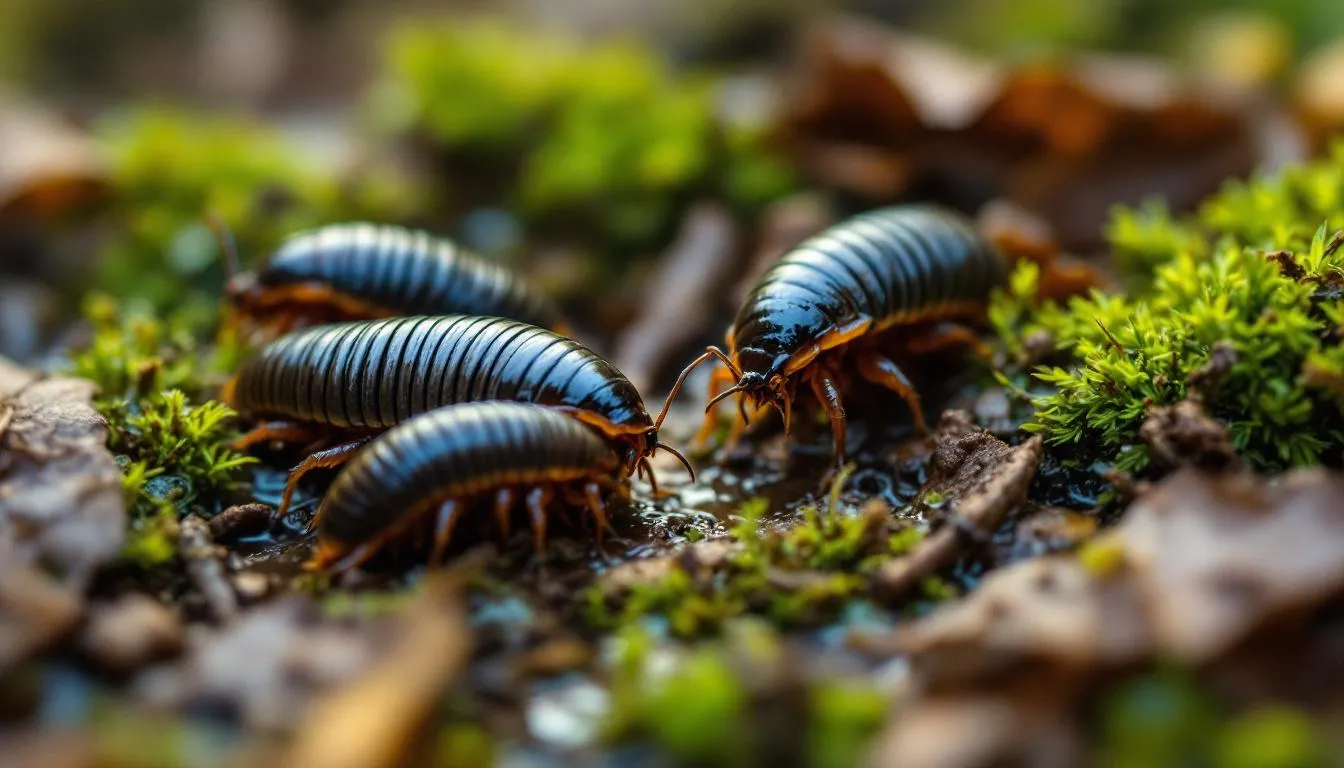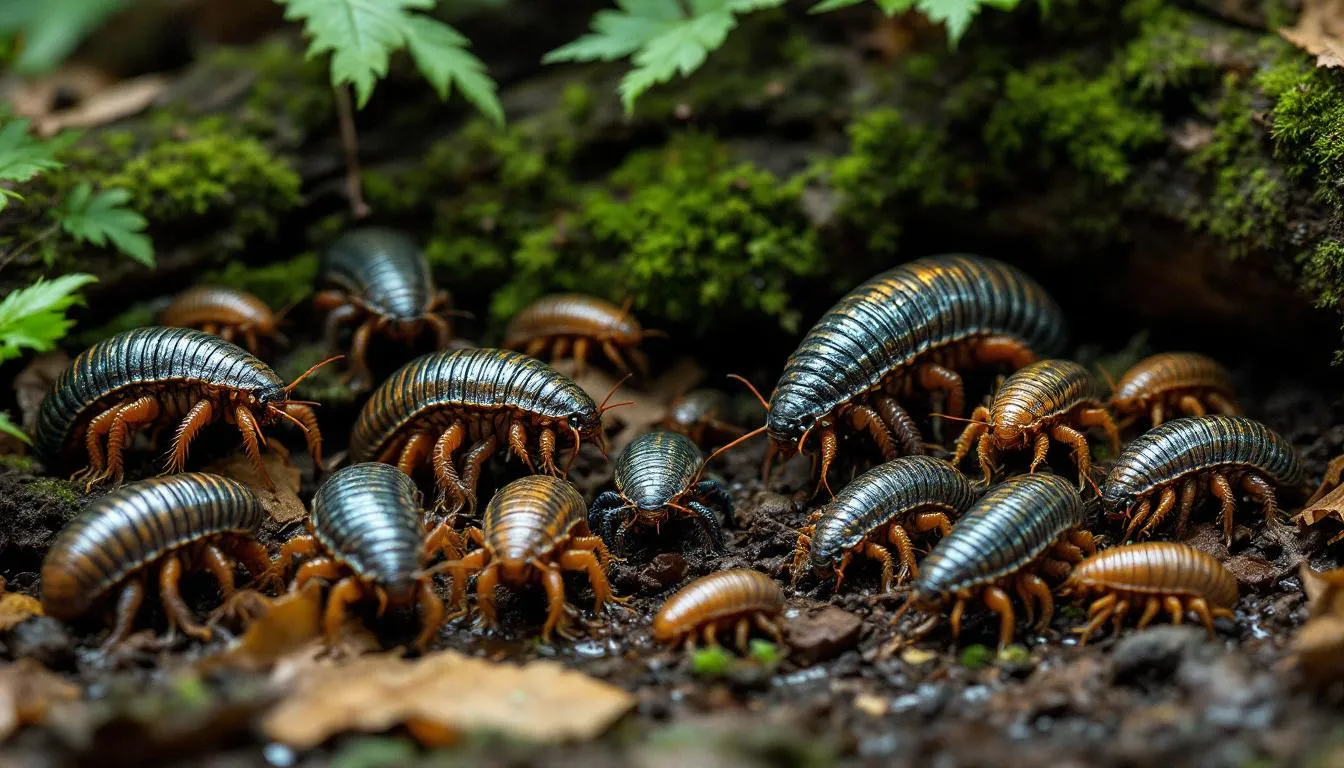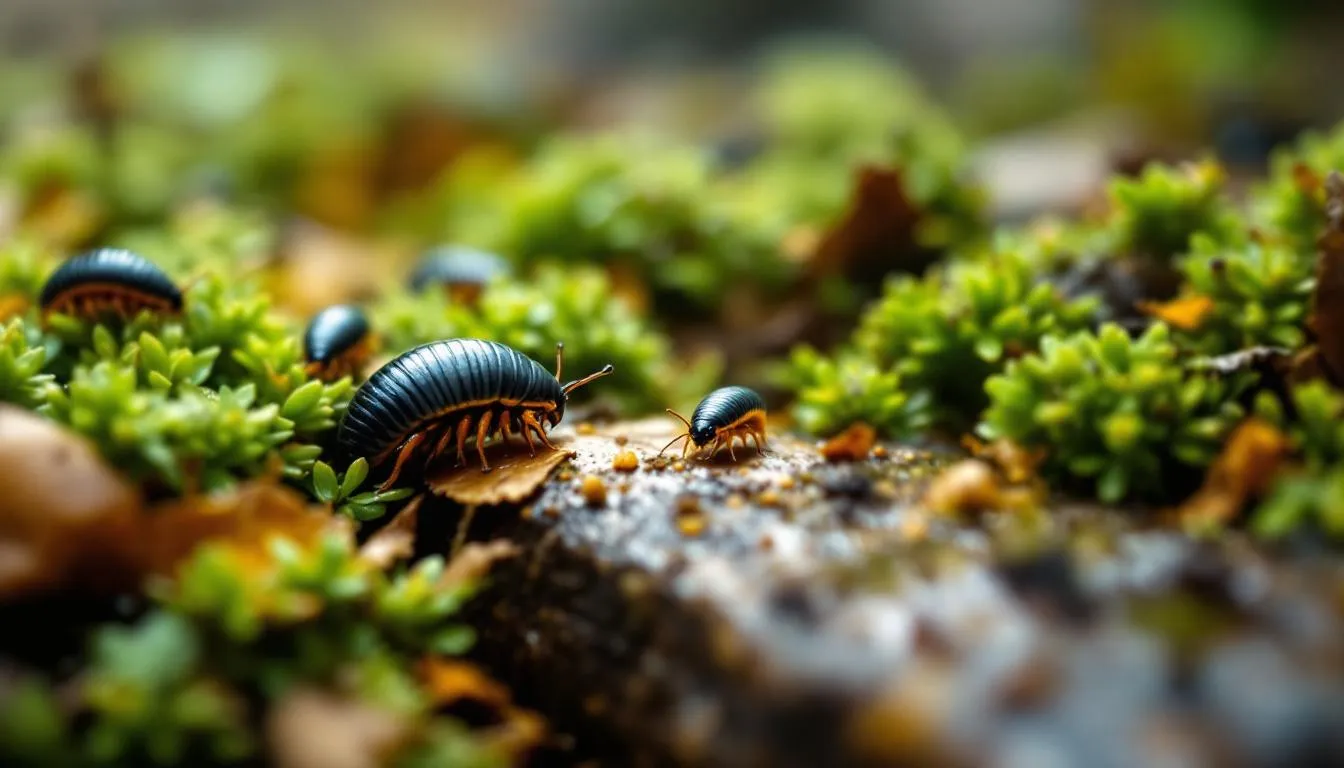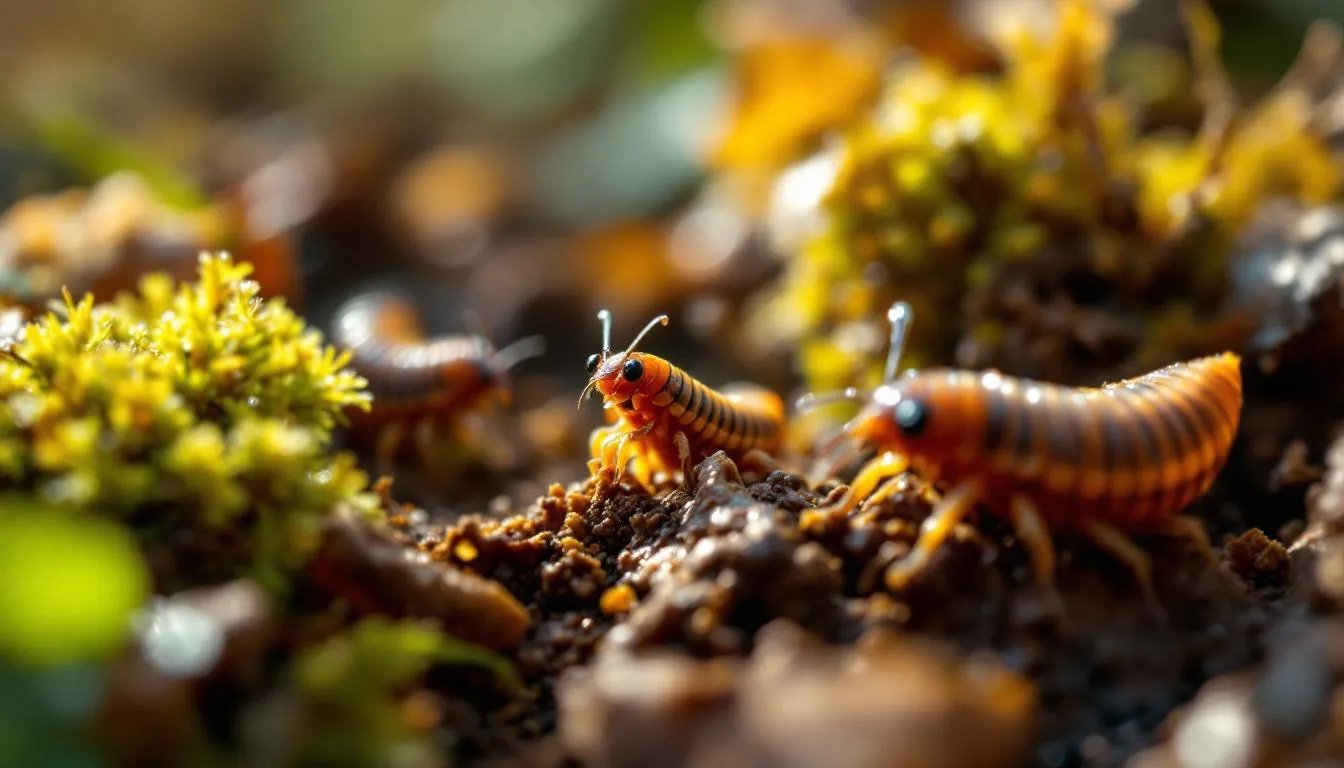Woodlice are small crustaceans commonly found in damp environments. If you’re finding them in your home, they’re likely seeking moisture and food. This guide covers everything you need to know about woodlice and how to control an infestation effectively.
Key Takeaways
-
Woodlice are terrestrial crustaceans that thrive in moist environments and play a vital role in nutrient cycling as decomposers.
-
Preventing woodlice infestations involves sealing entry points, reducing moisture levels, and managing vegetation around the home.
-
Effective control methods include using chemical sprays, diatomaceous earth, or smoke bombs, alongside outdoor management practices to deter woodlice from entering.
Understanding Woodlice

Woodlice are fascinating isopod creatures, belonging to the isopod group of terrestrial crustaceans closely related to crabs and lobsters, specifically within the suborder oniscidea. With seven pairs of legs and two antennae, these small gray pill-shaped insects are more than meets the eye. Thriving in moist environments, their origins date back to the Carboniferous period, predating the breakup of Pangaea. Animals like these play a crucial role in their ecosystems.
Despite their ancient lineage, woodlice have adapted remarkably well to modern environments. They are often found under rocks, in leaf litter, or even in our homes. Understanding their biology and behavior is crucial for effectively managing woodlice infestations.
Life Cycle and Reproduction
The life cycle of woodlice is quite unique, characterized by:
-
A two-phase molting process, where they shed their back half first before losing the front half a few days later.
-
Female woodlice carrying their fertilized eggs in a specialized pouch called a brood pouch.
-
The marsupium providing necessary nutrients and oxygen to the developing embryos.
When the young woodlice, known as mancae, emerge, they resemble small white versions of adults but initially lack one pair of legs. These immature young remain under maternal care after hatching, where they continue to grow and molt multiple times until reaching maturity. This close-knit family structure ensures the next generation’s survival and contributes to the woodlice population’s growth.
Common Species of Woodlice

Several species of woodlice are commonly found in homes and gardens, each with unique characteristics. The common shiny woodlouse, for instance, is gray with light patches and sometimes yellow flecks. These woodlice are often found in moist environments and are a frequent sight in many households.
Pill bugs, another common species, are known for their ability to roll into a ball when threatened, providing a natural defense mechanism against predators. Pillbugs typically inhabit compost heaps, where they help break down organic material.
The rough woodlice prefer drier environments and are usually woodlice found in leaf litter or on stone walls. They can grow up to 17mm in length and are a common sight in gardens, particularly the armadillidium vulgare.
The common pygmy woodlouse is reddish-brown and thrives in damp, dark environments, often found under stones. The common striped woodlouse, on the other hand, is well-suited to living in leaf litter. With a maximum length of 11mm, these yellowish-brown woodlice with a dark stripe are known for being fast runners.
Identifying these species aids homeowners in effectively managing woodlice infestations.
What Do Woodlice Eat?
Woodlice have a diet primarily consisting of rotting wood, decaying plants, mold, and mildew. This preference for decomposing organic material makes them efficient components of compost heaps, where they help break down and recycle nutrients back into the soil.
Their ability to sense food through taste and smell allows woodlice to locate decaying matter in their environment, ensuring they find ample food sources to feed. While their feeding habits contribute to nutrient cycling in nature, these same habits can lead to woodlice infestations in homes where they seek out similar food sources.
How Woodlice Enter Homes
Woodlice typically enter homes through small openings in walls, floors, and foundations, or via open doors and windows. Moist or damp areas, combined with high humidity levels or water leaks, attract woodlice to indoor environments. These conditions mimic their natural habitats, making basements, crawl spaces, and kitchens common gathering spots for these creatures.
Persistent water leaks and condensation can further attract woodlice into homes. An infestation of woodlice often signals underlying dampness issues within a property that need addressing to prevent future problems.
Signs of a Woodlice Infestation

Timely intervention requires recognizing the signs of a woodlice infestation. Visible woodlice crawling on surfaces and the presence of shredded plant material are clear indicators of an infestation. These signs suggest that woodlice are actively seeking food and shelter within the home.
Woodlice can also cause superficial damage to wooden structures by feeding on decaying wood. While this damage is usually not severe, it can be a nuisance and indicate the presence of a larger infestation.
Preventing Woodlice Infestations
Preventing woodlice infestations begins with regular checks and maintenance. Key steps include:
-
Sealing entry points like vents and pipes to keep woodlice out
-
Cleaning gutters
-
Ensuring access points are sealed These measures are essential in preventing woodlice from entering the house.
Dehumidifiers can lower humidity levels, making the indoor environment less favorable for woodlice. Frequent sightings of woodlice indoors often indicate underlying moisture problems, making it vital to address any damp issues within the home.
To reduce the chances to prevent woodlice from entering your home, consider the following preventive measures:
-
Keep firewood and other wooden materials stored away from the house.
-
Maintain a tidy garden by removing vegetation and organic matter around the home.
-
Regularly clean gutters to prevent water accumulation.
Effective Woodlice Control Methods
When prevention falls short, several control methods can manage woodlice infestations effectively. Suitable woodlice killer products, such as sprays and dusts, are essential for effective control. Popular options include Pro-Active C Woodlice Killer and insecticide sprays with active ingredients like Permethrin.
For those seeking chemicals-free solutions, Diatomaceous Earth and Silicon Dust are powders that kill woodlice by damaging their exoskeletons. Combining quick-acting sprays with long-lasting residual products enhances woodlice control effectiveness.
For severe cases, a woodlice smoke bomb can release fumes to kill woodlice in large areas. Keep children and pets away from treated areas until surfaces are dry. Woodlice killer kits provide comprehensive treatment solutions for either a single room or an entire house.
Outdoor Woodlice Management
Outdoor woodlice management is essential to prevent indoor infestations. Removing vegetation near the home significantly reduces woodlice populations. Debris in gutters provides food and shelter for woodlice, making regular cleaning crucial.
Insecticidal powder around the base of walls and air bricks deters woodlice from entering the home. These outdoor pest control management practices are key to controlling a woodlice-free indoor environment.
The Role of Woodlice in Ecosystems

While woodlice can be pests indoors, they play a vital role in ecosystems. As decomposers, they break down organic material and contribute to nutrient cycling. By feeding on decaying plant material, woodlice help enrich the soil and support plant growth.
These crustaceans serve as detritivores, aiding in nutrient recycling within ecosystems. Their presence in gardens indicates a healthy ecosystem, as they help maintain soil health by breaking down leaf litter and fallen fruit, contributing to biodiversity.
Appreciating the ecological role of woodlice helps homeowners tolerate their presence outdoors, even while taking measures for conservation to exclude them from their habitat.
Are Woodlice Harmful?
Woodlice are not particularly harmful outdoors and play a beneficial role in nature. However, their presence indoors can cause superficial damage, particularly to wooden objects and decorations. While they do not damage sound wood, they may accelerate decay in already damaged wood if present in large numbers.
Woodlice are not known to transmit disease. They are generally not dangerous to humans. They typically enter buildings seeking moisture and shelter from extreme weather conditions, making them more of a nuisance than a serious threat.
Summary
In conclusion, understanding woodlice and their behavior is key to managing and preventing infestations. From identifying common species to implementing effective control methods, homeowners can take proactive steps to keep these pests at bay. Regular maintenance, proper storage of materials, and addressing moisture issues are crucial in preventing woodlice from entering homes.
By appreciating the ecological role of woodlice, we can better manage their presence in our gardens while ensuring they do not become a nuisance indoors. Implementing the tips and methods provided in this guide will help you maintain a woodlice-free home and a healthy outdoor environment.
Frequently Asked Questions
How can I prevent woodlice from entering my home?
To effectively prevent woodlice from entering your home, seal potential entry points and reduce moisture levels. Additionally, keep gutters clean, store firewood away from the house, and maintain a tidy garden.
What are the signs of a woodlice infestation?
The presence of woodlice crawling on surfaces, along with shredded plant material and noticeable damage to wooden structures, are clear signs of an infestation. Addressing these indicators promptly is essential to manage the issue effectively.
Are woodlice harmful to humans?
Woodlice are not harmful to humans as they do not transmit diseases and pose no serious threat; they are primarily considered a nuisance.
What do woodlice eat?
Woodlice primarily consume rotting wood, decaying plants, mold, and mildew, serving as efficient decomposers that aid in nutrient cycling in ecosystems.
What are effective methods for controlling woodlice?
Effective methods for controlling woodlice include using suitable pesticides like sprays and dusts, as well as chemical-free options such as Diatomaceous Earth and Silicon Dust. Combining quick-acting products with long-lasting residual options can significantly improve your control efforts.









